Half a century ago, the “London Stone” returned to its rightful place and the Cuban missile crisis was resolved soon afterwards.
In a fortnight’s time it will make a similar journey home. “We are hoping all the modern woes of life might be reversed now the karma is being restored,” said the Museum of London curator Roy Stephenson.
The London Stone is a not particularly attractive lump of sooty limestone. But it has been laden with a plethora of myths and mysteries, including the belief that if it is moved from its home in the City then London will no longer flourish.
Perhaps for that reason, it has always stayed at 111 Cannon Street, apart from in 1960 when it was moved temporarily to the Guildhall Museum while construction work took place. In 2016 it was transferred to the Museum of London for similar reasons.

On 4 October it will return to its traditional home at 111 Cannon Street, this time to be housed in a newly built retail and office block.
Stephenson, London’s historic environment lead at the Museum of London, said the 76kg stone had never left the City of London’s boundaries so “hopefully we didn’t upset the chakra or the karma which is associated with it.
“It all might be a load of rubbish but who knows, it is better to be on the safe side. I’m really pleased with where it is going … maybe there will be a solution to Brexit.”
Among the stories which surround the stone are that it was brought to London by Brutus, the legendary founder of Britain, with the saying: “So long as the stone of Brutus is safe, so long shall London flourish.”
Across the centuries it has been claimed to be variously a Roman monument or milestone; or was it the stone from which Arthur pulled out his sword Excalibur?
It has been referenced by writers and artists, including Shakespeare in Henry VI Part 2. In the play, the Kentish rebel Jack Cade uses the stone as a throne. “And here, sitting upon London-stone, I charge and command that, of the city’s cost, the pissing-conduit run nothing but claret wine this first year of our reign. And now henceforward it shall be treason for any that calls me other than Lord Mortimer.”
A soldier then runs in, shouting “Jack Cade! Jack Cade!” and is killed instantly.
William Blake identified the stone as an altar stone where druids carried out bloody sacrifices: “And the Druid’s golden knife/Rioted in human gore,/ In offerings of human life./ They groan’d aloud on London stone.”
In the 18th century the stone was deemed to be blocking the road so was moved in to an alcove of St Swithin’s Church, a Wren building which was gutted in the Blitz. After the demolition of the church’s ruins in 1960 it was moved temporarily to the Guildhall Museum.
In 1962 it went into a grilled and glazed alcove in a building which has been the Bank of China, a sports shop and a WH Smith.
Stephenson said the developers of the new building were creating a fine home for the London Stone. “They have done a lovely job, it is like a mini-city centre apartment for the stone with a view out on to Cannon Street.”
He said the museum had been proud to be temporary custodian – sometimes attracting a different kind of visitor. “We have had a few slightly whacky people through the galleries.”
Whether its return will have any impact on anything whatsoever remains to be seen.
“You laugh, but the last time it was restored the Cuban missile crisis was sorted out,” said Stephenson. “Mind you Kennedy was assassinated shortly afterwards too.”
